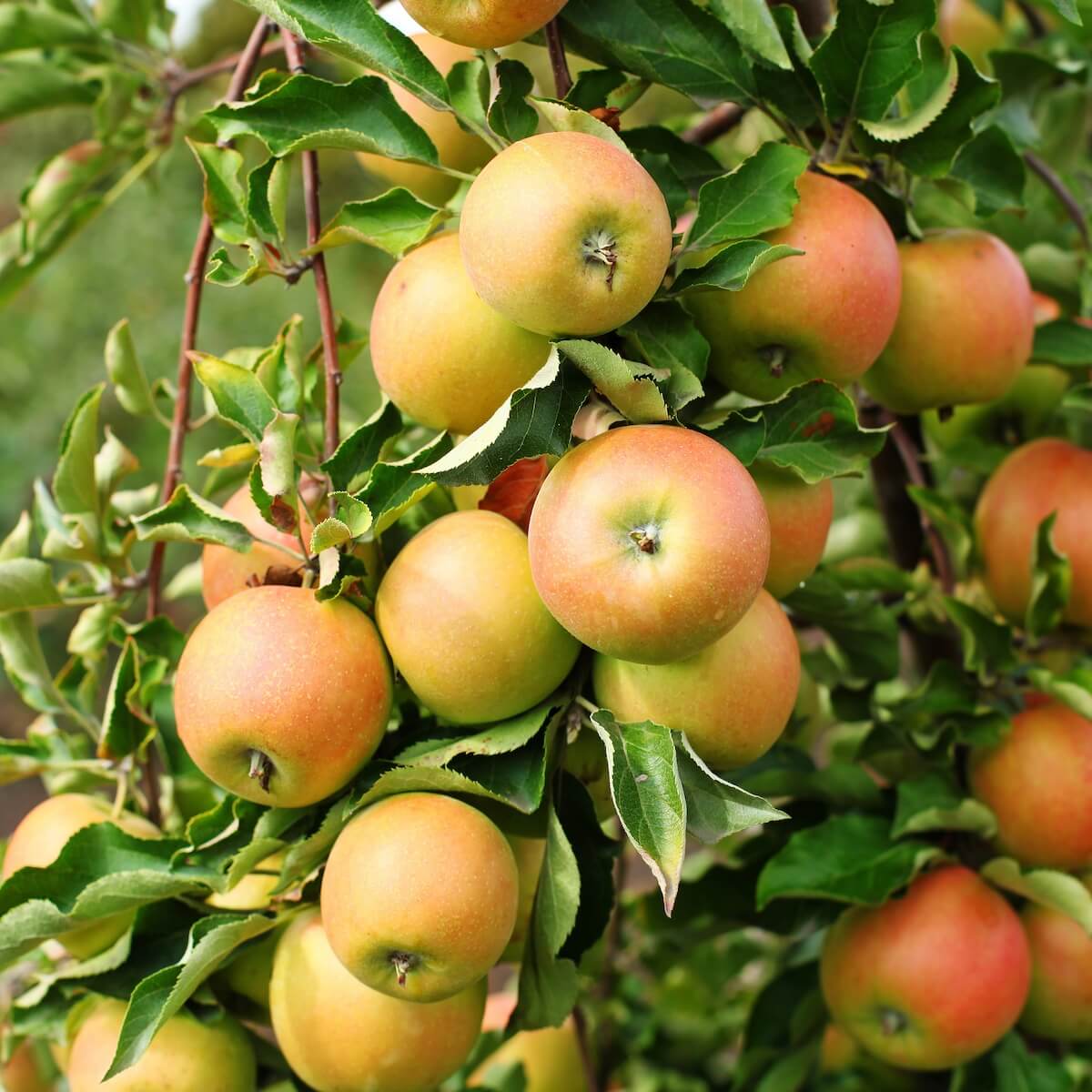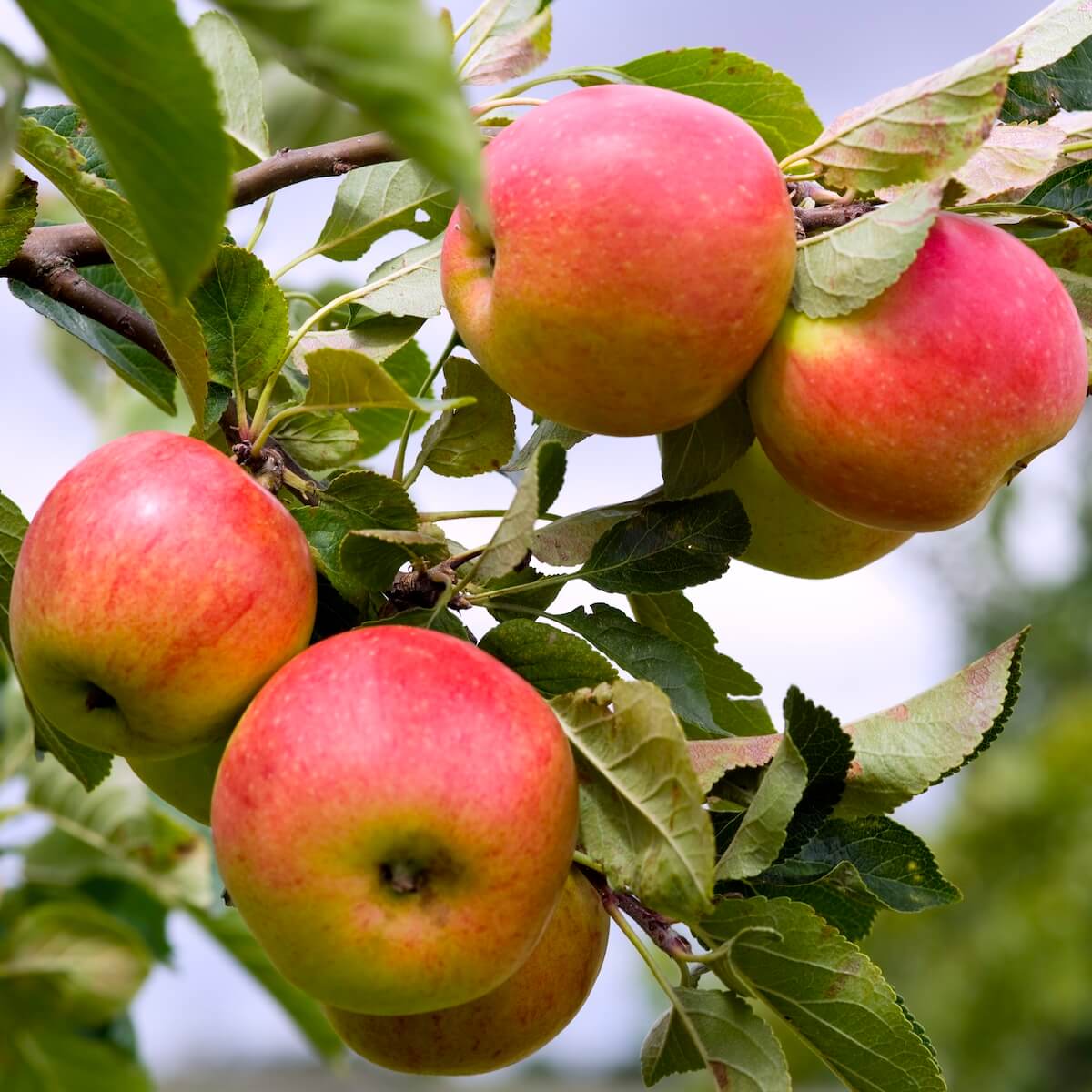
Position
- Full sun
- Sheltered from strong winds
- South or south-west facing aspect
- Avoid frost pockets
Hardiness
- Hardy down to -20°C (-4°F)
- Requires winter chilling for good fruiting
Soil
- Well-drained, fertile loam
- Can tolerate clay if drainage is improved
- Avoid waterlogged conditions
- Tolerates neutral to slightly alkaline soils (6.5-7.5)
- Grab a soil test kit and ensure the perfect conditions for growth
Height
- On M26 rootstock: 2.5-3 metres (8-10 feet)
- On M9 rootstock: 1.8-2.4 metres (6-8 feet)
Seasons of Interest
- Spring flowering: Mid-April to early May
- White-pink blossom
- Fruit development: July-September
- Harvest period: Late August to early September
- Autumn foliage: Yellow-orange tones in October
Additional Notes
- Self-fertile but crops better with a pollination partner
- Excellent disease resistance, particularly to scab
- Produces sweet, strawberry-flavoured apples
- Benefits from annual mulching
- Requires regular pruning in winter
- Fruit stores for approximately 2-3 weeks after picking
- Ideal for smaller gardens and beginners
- Can be grown as an espalier or a cordon
- Good resistance to late frosts due to a later flowering period
- Popular choice for organic growing due to natural disease resistance
How to Care for Your Apple Worcester Pearmain
Apple Worcester Pearmain is a cherished early-season variety with a rich history and a unique, sweet flavour. Whether you’re a home gardener or an orchard enthusiast, this fruit tree offers an excellent harvest of delicious apples with a hint of strawberry flavour. This guide explores everything you need to know about growing, caring for, and enjoying this traditional British apple.
What Makes Worcester Pearmain Apples Special?
Worcester Pearmain apples are prized for their juicy texture and distinct strawberry flavour. First introduced in the late 19th century, this variety remains popular for its early ripening and reliable cropping. The apples are best enjoyed fresh from the tree, as they don’t keep well for long periods.
This variety is also known for its attractive blossom, making it a beautiful addition to any garden. Whether you grow it for its fruit or ornamental appeal, Apple Worcester Pearmain is a worthwhile choice.
What Is the History of the Worcester Pearmain Apple?
The Worcester Pearmain apple originated in England and was first introduced by a nursery in Kent. In 1875, the Royal Horticultural Society (RHS) recognised it and awarded a First Class Certificate for its outstanding qualities. It is believed to be a seedling of the Devonshire Quarrenden, another well-regarded early-season English apple.
The Worcester Pearmain remains a relatively popular apple variety grown commercially and on a small scale in home gardens. The tree register indicates that many orchards still cultivate this variety, ensuring its continued presence in British gardens.
What Are the Best Growing Conditions for Worcester Pearmain?

How to Plant and Care for a Worcester Pearmain Apple Tree
Planting a Worcester Pearmain apple tree requires careful preparation. Dig a planting hole wide enough to accommodate the tree’s roots comfortably. Place the tree in the hole, ensuring that the base of the tree is level with the soil surface. Fill the hole with soil and firm it down gently to remove air pockets.
Water the tree thoroughly after planting and apply a layer of mulch to retain moisture. Regular pruning will help shape the tree and encourage fruit production. Since Worcester Pearmain is a partial tip bearer, avoid excessive pruning that removes fruiting wood.
What Is the Best Rootstock for Worcester Pearmain?
Choosing the right rootstock affects the tree’s vigour and ultimate size. Worcester Pearmain can be grown on various rootstocks, including:
- M26: A semi-dwarfing rootstock ideal for small gardens.
- MM106: A semi-vigorous rootstock that produces larger trees suitable for orchard planting.
- M9: A dwarf rootstock for container growing or compact spaces.
Selecting the appropriate rootstock ensures that the tree grows to a defined plant size, making it easier to manage and harvest fruit.
How Does Worcester Pearmain Pollinate?
Worcester Pearmain is partially self-fertile, meaning it can produce some fruit without a pollination partner. However, to ensure a good crop, plant suitable pollination partners nearby. It belongs to pollination group 3, so trees from the same or adjacent groups will improve fruiting.
Recommended pollination partners include:
These apple trees will enhance pollination and lead to better fruit production. Please check out my article here for more information on Apple pollinating groups.
When Is Worcester Pearmain Ready for Harvesting?
Worcester Pearmain apples ripen early, usually from late July to mid-October. They should be left on the tree as long as possible before picking for the best flavour. If harvested too early, they may lack sweetness and juiciness.
Because these apples do not keep well, they should be eaten soon after picking. They taste best when enjoyed fresh, but they can also be used to make apple flans or juice.
Is Worcester Pearmain Resistant to Pests and Diseases?
Worcester Pearmain has moderate resistance to common apple tree diseases such as apple scab and canker. However, proper care and maintenance can further reduce the risk of infections. To keep the tree healthy:
Remove any fallen fruit that has holes or signs of disease.
Prune regularly to improve air circulation and reduce the chances of mildew, which can affect the quality of the apples on the tree.
Apply organic sprays to deter pests and fungal infections.
From Darren’s Patch
Although I don’t currently grow Worcester Pearmain in my garden, I’ve always admired this lovely old variety. It’s one of those apples that takes you back – full of traditional charm, with an unmistakable sweet strawberry flavour that sings of late summer. Friends who grow it always rave about how early it fruits and how pretty the blossom is – and honestly, it’s hard to beat that combination of good looks and great taste. I often recommend it to anyone wanting to grow their first apple, especially if they’re short on space or want something that fruits reliably year after year. While it’s not the longest keeper, the joy of picking a crisp, sun-warmed Worcester straight from the tree and biting into it is one of those simple pleasures that makes gardening feel worth it. If I had room for another tree, this one would be near the top of my list!
![]()
Key Points to Remember:
- Worcester Pearmain is an early-season English apple known for its intense strawberry flavour
- It was introduced by a nursery in Kent and awarded a First Class Certificate by the RHS in 1875
- The tree thrives in a sheltered, sunny position with well-drained soil
- Suitable rootstocks include M26, MM106, and M9 for different garden sizes
- It is partially self-fertile but benefits from pollination partners such as Discovery and Cox’s Orange Pippin
- The apples ripen between late July and mid-October and are best eaten fresh
- Worcester Pearmain is resistant to scab and canker but requires proper care to maintain health
- Trees can be purchased from reputable nurseries, either locally or by ordering online
Whether planting for the first time or adding to an existing orchard, the Worcester Pearmain apple tree is an excellent choice. Its flavour, history, and ease of growing make it a rewarding addition to any garden. Start growing your own and enjoy the delicious apples straight from the tree!
To see the RHS article, please click here.
Want to learn about other apple varieties? Read about Apple Blenheim Orange here.
For more information on Fruit for your garden, please click here.
Frequently Asked Questions
Q: What makes the Worcester Pearmain apple tree a good choice for my garden?
A: Apple Worcester Pearmain is a fantastic early-season dessert apple known for its delicious flavour and reliable cropping. It is an excellent choice for small-scale gardening, as the tree is vigorous yet manageable and produces a good harvest of apples each year.
Q: Where can I buy a Worcester Pearmain apple tree?
A: Garden centres and online retailers offer Worcester Pearmain apple trees. When purchasing, look for reputable suppliers or RHS-affiliated nurseries to ensure you get a healthy, high-quality tree.
Q: Are Worcester Pearmain apples suitable for commercial growing?
A: Worcester Pearmain apples are grown commercially due to their popularity and reliable early yields. In 1875, they received a First Class Certificate from the Royal Horticultural Society, highlighting their excellent quality and suitability for cultivation.
Q: What does a Worcester Pearmain apple taste like?
A: Worcester Pearmain apples have a sweet yet slightly tangy flavour and crisp texture. They are delightful when eaten fresh but can also be used in various culinary dishes.
Q: Do I need a pollination partner for my Worcester Pearmain apple tree?
A: While the Worcester Pearmain is partially self-fertile, having a pollination partner will improve fruit yield. Good pollination partners include varieties such as ‘Devonshire Quarrenden’, which will help ensure a more abundant harvest.
Q: How do I care for my Worcester Pearmain apple tree?
A: To keep your tree healthy and productive:
- Plant it in a sunny location with well-drained soil.
- Water regularly, especially during dry periods.
- Feed in early spring with a balanced fruit tree feed.
- Prune to maintain its shape and encourage good airflow.
- This variety has good resistance to mildew, making it relatively easy to manage.
Q: How long does a Worcester Pearmain apple tree take to bear fruit?
A: Worcester Pearmain apple trees usually produce fruit within 3 to 5 years of planting. With the proper care, you can look forward to enjoying homegrown apples in just a few seasons!
Q: Can I grow Worcester Pearmain apples in pots?
A: Yes! Worcester Pearmain apple trees can be successfully grown in pots, making them ideal for patios or small gardens. Please ensure the pot is large enough for the root system, and use well-draining compost and water regularly to keep the tree healthy.
Q: What should I look for when buying a Worcester Pearmain apple tree?
A: When choosing a tree, look for:
- Healthy, green foliage with no signs of disease.
- A sturdy, well-formed trunk.
- A strong root system, ideally from a reputable nursery.
Opting for a disease-resistant variety will also help ensure a long-lasting and productive tree.
